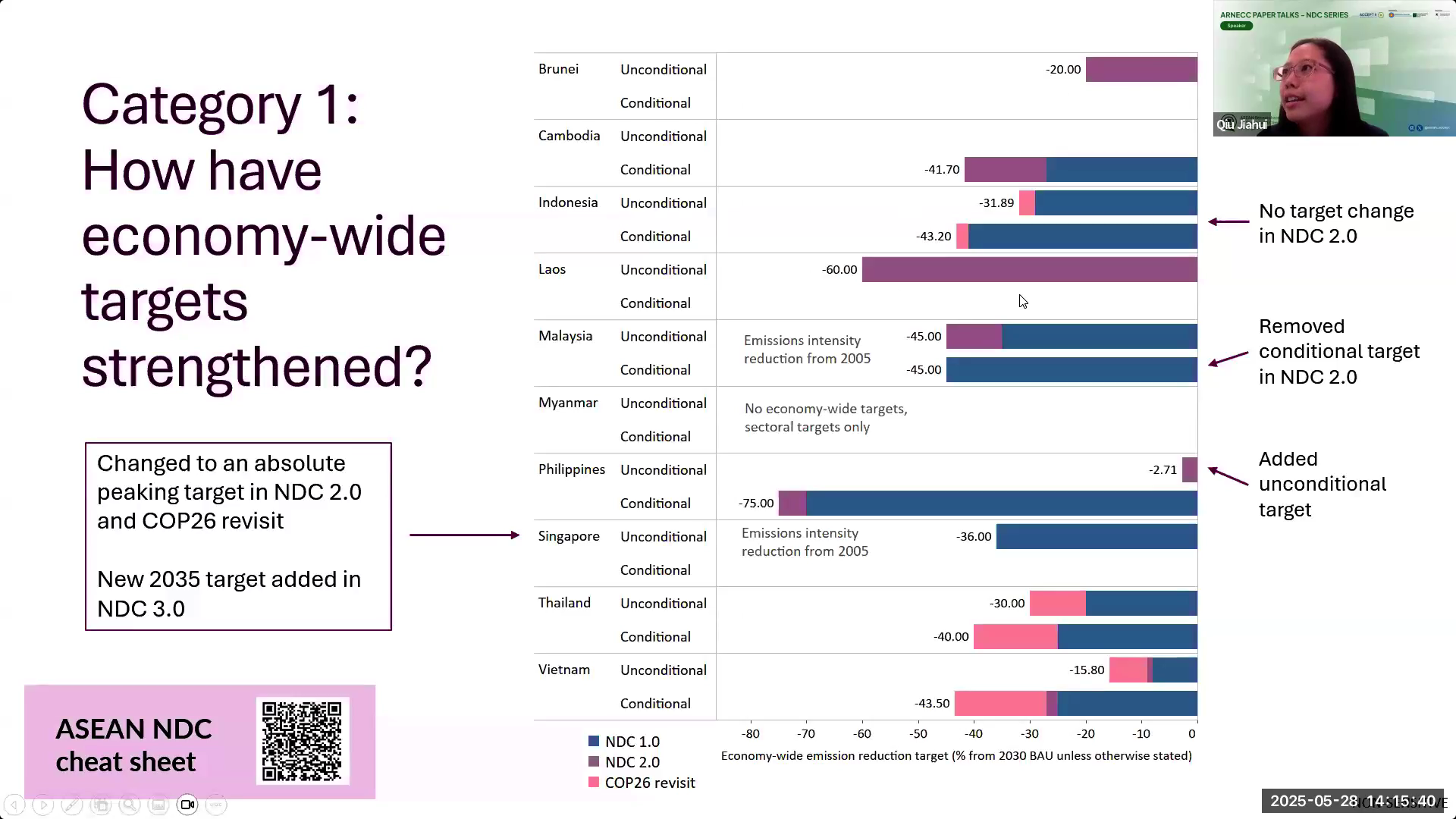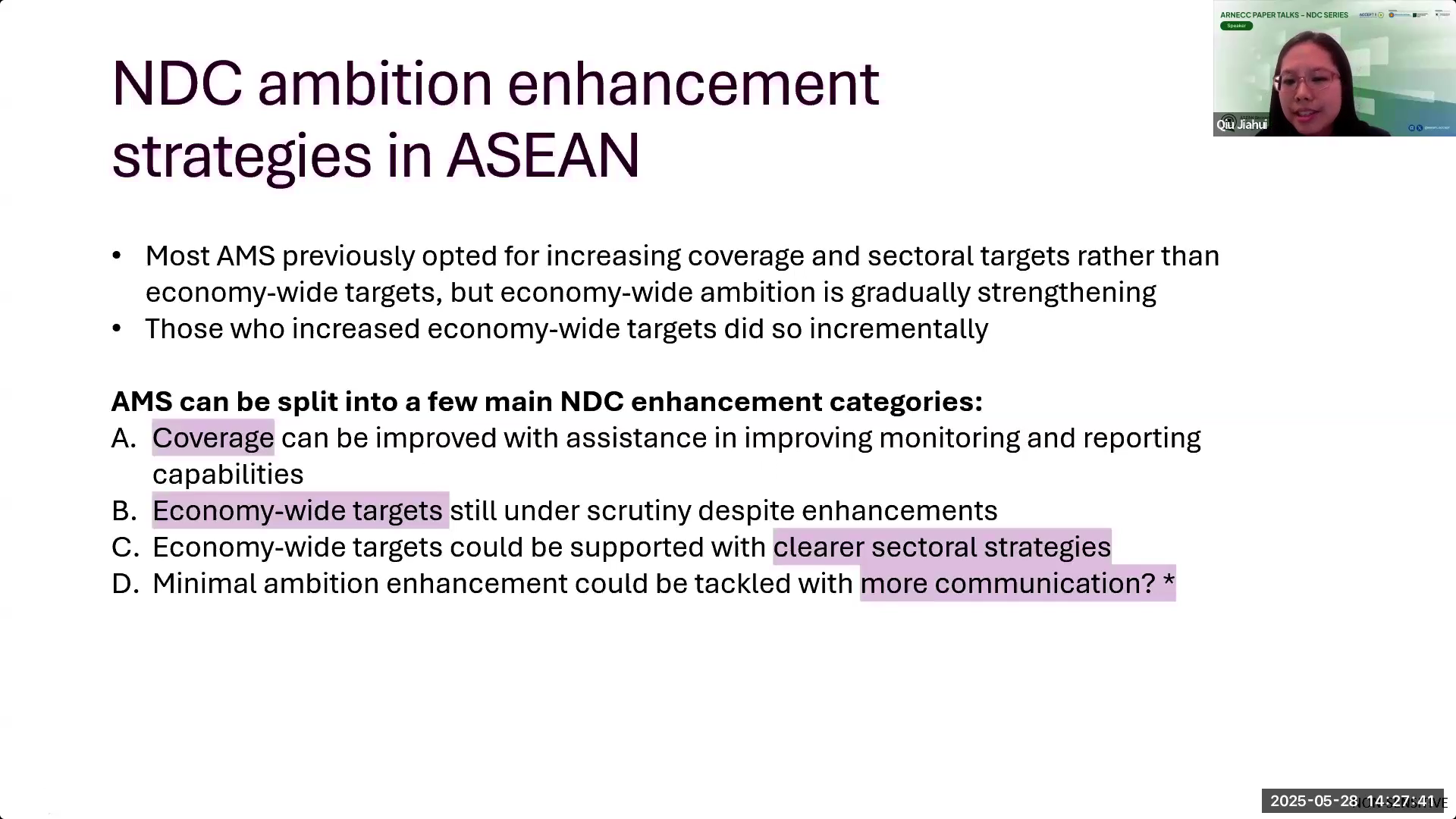Jakarta, 28 May 2025

Photo 1. Ms. Jiahui Qiu, ISEAS–Yusok Ishak Institute, and Ms. Indira Pradnyaswari, Research Analyst for ACCEPT at the first ARNECC Paper Talks – NDC Series
Jakarta, 28 May 2025 — An insightful session unfolded at the latest ASEAN Research Network on Energy and Climate Change (ARNECC) Paper Talks. Organised under the ASEAN Climate Change and Energy Project (ACCEPT) Phase II, the event aims to draw a diverse group of academics, policymakers, and civil society representatives eager to unpack the region’s evolving climate commitments. This year’s theme revolves around the discussion of ASEAN’s progress in their respective Nationally Determined Contributions (NDCs). To kickstart this series, Ms. Jiahui Qiu from the ISEAS-Yusof Ishak Institute presented her academic analysis titled “Examining Climate Ambition Enhancement in ASEAN Countries’ Nationally Determined Contributions.“

Photo 2. Opening Session of the ARNECC Paper Talk led by Master of Ceremony, Haningrum Eka Putri Rahayu (Research Assistant for ACCEPT II)
The talk was led by Ms. Haningrum Eka Putri Rahayu, Research Assistant for ACCEPT II as the Master of Ceremony, and moderated by Ms. Indira Pradnyaswari, Research Analyst for ACCEPT II. To establish the baseline for the discussion, Ms. Qiu iterated that the paper’s focus was on how ASEAN Member States (AMS) are responding to the Paris Agreement’s call for progressively stronger NDCs to achieve the 1.5°C target. Ms. Qiu’s presentation dissected the recent updates and directions of ASEAN countries’ NDCs, revealing a landscape of both promising shifts and persistent challenges.

Photo 3. Presentation by Ms. Jiahui Qiu from the ISEAS-Yusof Ishak Institute on the categories used to analyse the Member States’ NDC progress
Ms. Qiu stated that the paper specifically focuses on comparing the current NDCs with their previous versions to identify where and how countries have enhanced their commitments — whether through stronger targets, expanded sectoral coverage, or improved policy frameworks. She outlined several categories to map each Member States’ progress and highlights opportunities to prioritise and develop shared learning and mutual accountability across the region; (1) How have economy-wide targets strengthened?; (2) How was sector coverage ambition strengthened?; (3) Were sectoral non-GHG targets strengthened?; and (4) Were sectoral actions strengthened?

Photo 4. Presentation by Ms. Jiahui Qiu on NDC Ambition Enhancement Strategies in ASEAN
The results underscored the enduring reliance on conditional targets that require external support — a reflection of unequal capacities across the region. By analysing countries’ approaches, public perceptions, and comparing NDCs to other national climate policies, the ASEAN Member States (AMS) were divided into four categories based on their progress.
Lower-income countries like Cambodia, Lao PDR, and Myanmar have made good attempts to increase their economy-wide target and their sectoral targets. However, coverage can be improved with international assistance in improving monitoring and reporting capabilities. With greater monitoring capabilities, they can further understand their activities related to greenhouse gas emissions which will be the basis for an even stronger ambition. These countries may also face a challenge in implementation and need to secure robust financing strategies to meet these targets.
Higher income countries, such as Brunei Darussalam, Singapore, and Vietnam are still under scrutiny despite enhancement and are under increasing international pressure to lead by example. For Malaysia and the Philippines, economy-wide targets could be supported with clearer sectoral strategies. On the other hand, Indonesia and Thailand could tackle minimal ambition enhancement with more communication on their strategies to achieve their ambitions.
Member States must further enhance climate ambition and improve how they communicate current efforts and actions to the public. AMS in the same categories facing similar challenges can benefit from sharing experiences. However, inconsistencies in NDC structures and reporting mechanisms pose a considerable barrier to tracking collective progress. Without harmonised base years, target formats, and sectoral scopes, regional comparisons remain patchy and inconclusive.
Interactive Q&A: Unpacking the Gaps and Opportunities
During the Q&A session, Ms. Qiu addressed several critical aspects bridging theory and practice. She acknowledged that while there is growing momentum for the regional harmonisation of NDC targets within ASEAN, no formal framework currently exists. Achieving such alignment would require not only political commitment but also improved data standardiation. On financing, she emphasised the indispensable role of development partners, who not only provide funding but also strengthen institutional capacity and ensure the enforcement of regulatory safeguards.
Ms. Qiu further highlighted the United Nations Framework Convention on Climate Change (UNFCCC)’s Enhanced Transparency Framework as the most comprehensive tool available for monitoring, reporting, and verifying net-zero commitments. She also underlined the importance of civil society and subnational actors as vital connectors between government policy and grassroots implementation. As an example, she noted that Brunei’s methane mitigation efforts exemplify sectoral alignment with national climate goals, while reinforcing that community engagement remains essential to complement large-scale public finance, particularly in sectors such as agriculture.
In defining strengthened NDCs, she pointed to the need for new targets, more ambitious timelines, and a shift toward absolute emissions reductions, citing Singapore’s transition as a benchmark. Concluding the session, she highlighted the potential of initiatives like the Just Energy Transition Partnership (JETP) as models for fostering greater regional collaboration and accelerating climate ambition across ASEAN.
Conclusion: Bridging Ambition and Implementation for Enhanced NDCs
The session concluded with a shared understanding that while AMS are indeed enhancing their climate ambitions, the journey toward achieving — let alone surpassing — their NDC targets remains uneven and uncertain. Technical capacity, financial support, regional harmonisation, and public engagement are all critical levers that must be simultaneously pulled.
Through this discussion, it is clear that there exists an urgency for the AMS to increase their ambitions. Since NDCs are nationally determined, there is a wide variety of countries’ timelines, scope, and targets. This diversity, while reflective to domestic’s circumstances and capacities, also poses as challenges for regional coherence and accelerated collective progress. The discussion made one thing clear: the path to climate resilience in Southeast Asia must be paved with both bold commitments and collaborative action. As the 2030 deadline looms, the urgency to transform ambition into action has never been greater.
To further read Ms. Qiu’s research paper, you can visit the ARNECC Research Database on the ACCEPT website or click here to be redirected to the paper.
**
(LL, NA, HEPR, EMA)
Join our ASEAN Researchers Network on Climate Change (ARNECC) by registering yourself here. Become a part of our collaborative efforts to address pressing climate challenges and shape a sustainable future.
Detailed information on ACCEPT II can be found at https://accept.aseanenergy.org/
Follow our social media to stay updated on ASEAN’s energy-climate nexus and ACCEPT activities.
Instagram: instagram.com/asean_accept
X: x.com/asean_accept
We welcome any future collaborations. Please feel free to contact us at [email protected]